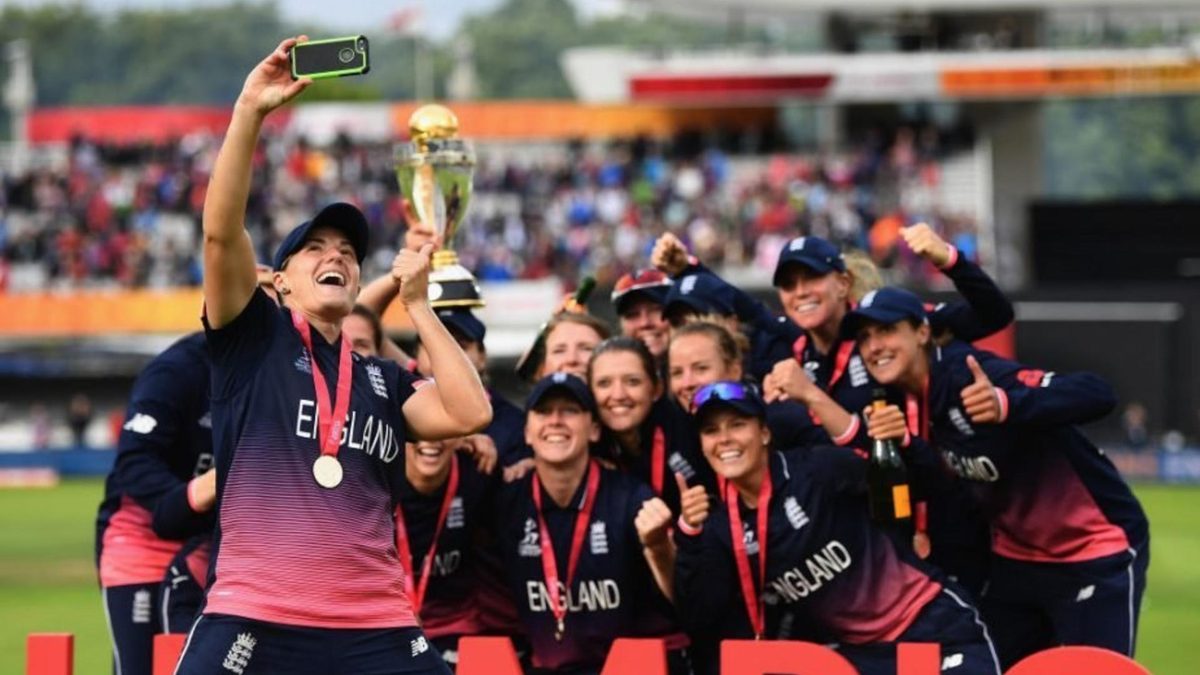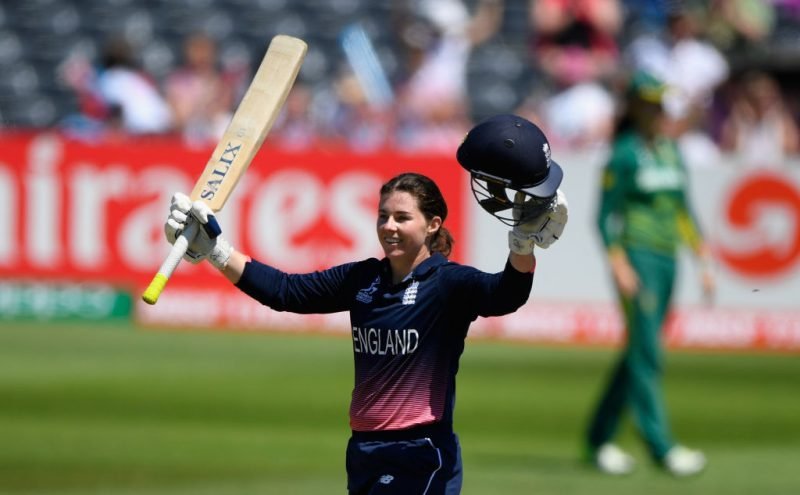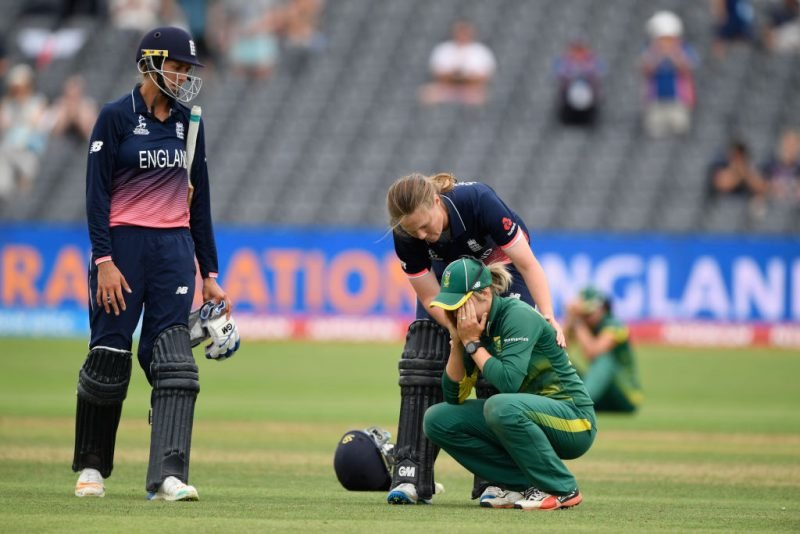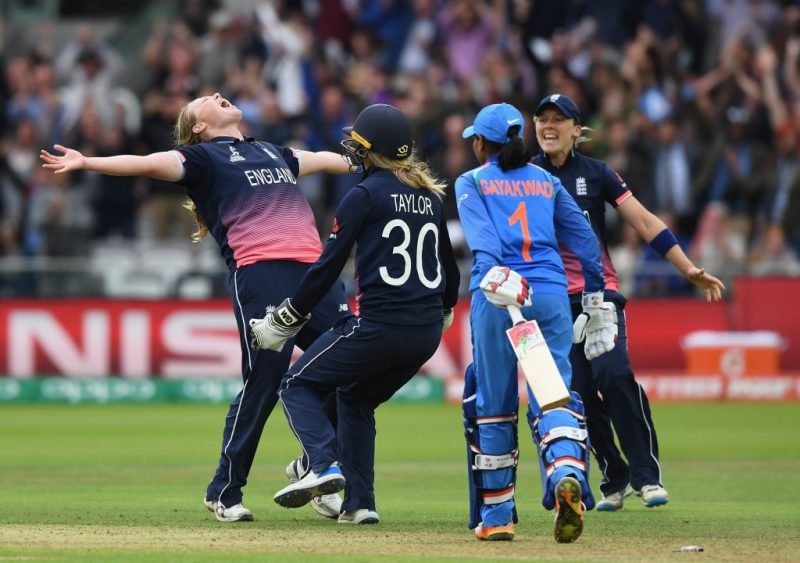
As England prepare to defend their 50-over World Cup title in New Zealand, Heather Knight, Anya Shrubsole and Alex Hartley speak to Taha Hashim about a historic campaign five years ago.
Heather Knight can remember the moment it kicked in. When she realised the enormity of where her teammates had got to. The England captain was lined up alongside her players, the anthems were underway at Lord’s, and the crowd was filtering in for a sold-out affair.
“We had Eileen Ash, who was 105 at the time, ringing the five-minute bell, and [a picture of] Rachael Heyhoe Flint on the screen. Just looking at the crowd I could see so many faces that I knew and that had been involved in women’s cricket. That was kind of when it hit me, when the anthems started, what a big day it was for English cricket and women’s cricket in general, and how special it was for so many people. That got the goosebumps going and definitely got me a bit emotional.”
And then, once the formalities were over, there was a game to play. Tammy Beaumont and Lauren Winfield walked out to bat, and India’s Jhulan Goswami took the new ball. The 2017 World Cup final was up and running.
***
The road to Lord’s had begun more than a year earlier with a cold-blooded call. After England fell to an agonising five-run defeat to Australia at the World T20 in March 2016, head coach Mark Robinson, just months into the job, was sat beside then-captain Charlotte Edwards in the post-match press conference when he delivered some home truths: “We’ve got to get fitter. We’re not fit enough. They outran us.”
But a few more minutes on the treadmill wasn’t going to be enough; it was time for radical change and a break from the old guard. Edwards, who’d given it everything in an England shirt, was stood down as skipper just weeks later and informed that it was time to have a look at the next generation. She swiftly called time on her England career.
“He [Robinson] changed English women’s cricket forever,” recalls Alex Hartley, the left-arm spinner who would make her international debut in 2016 against Pakistan and played in all but one of England’s nine matches at the World Cup. “It was a huge call to tell the greatest player of all time that her time was done and the team needed to move on.”
Knight took the captaincy and the new era began brightly; ODI series wins over Pakistan, Sri Lanka and West Indies preceded the start of a World Cup campaign on home soil. Yet questions remained over how England would fare against the bigger beasts and Australia began the tournament as favourites. “We obviously knew we could go a long way but we weren’t massively being talked about as favourites,” says Anya Shrubsole, the right-arm seamer who was set to play in her third 50-over World Cup, “so we were kind of able to, I guess, slip under the radar a little bit, which I think really helped us as a team.”
But the start was far from ideal. At Derby on June 24, Knight won the toss and chose to bowl against India, but it was the visitors who won the opening act. A 20-year-old Smriti Mandhana reeled off 90 from just 72 balls and a total of 281-3 was too much for England, who suffered four run-outs on their way to a 35-run defeat. “We got absolutely pummelled by India,” says Hartley. “I just remember watching Mandhana bat and she kept hitting boundary after boundary, and I remember thinking: ‘Oh my God, we’re going to lose this’.”
For Knight, however, this wasn’t the time to panic. “I chatted to Robbo before we went in the dressing room [after the match] to speak to the girls, and we both agreed that we would try and keep it quite positive and try and brush over it a little bit, because we’d made a few mistakes and been a bit overawed by the occasion.” Pakistan, the next game, was to be the focus, but the end-goal remained in sight too. “In the dressing room after and a few days later,” Hartley remembers, “we were like, ‘We’ve lost the first game, but let’s get to the final and, if we play India, let’s not let them win’.”
Three days on from the loss to India, there came a rousing turnaround at Leicester: Knight and Nat Sciver both hit their first ODI centuries and shared a 213-run partnership as England put up their highest total in a World Cup match and won by 107 runs on DLS. “We wanted to make a bit of a statement after that first game,” Knight recalls. Job done.
The England captain then top-scored with 82 and Laura Marsh took 4-45 as Sri Lanka were swept aside by seven wickets, and a 68-run win over South Africa was powered by a mammoth 275-run second-wicket stand between Tammy Beaumont (148 off 145 balls) and Sarah Taylor (147 off 104 balls). The former, whose first six years in international cricket provided little to shout about, had taken her chance at the top of the order after Edwards’ retirement and went on to finish the World Cup as the Player of the Tournament and leading run-scorer.
[caption id=”attachment_243513″ align=”alignnone” width=”800″] Tammy Beaumont celebrates her hundred against South Africa[/caption]
Tammy Beaumont celebrates her hundred against South Africa[/caption]
“I’d been housemates with Tammy Beaumont before that tournament and seen the highs and lows she’d had through her career,” says Hartley. “If you’d have looked at her stats before the tournament, you’d have probably thought that England were crazy to give her another opportunity. Pre-2016, she’d batted from one to 11 [the only position Beaumont had not batted in was No.4] and been awful, if we’re going to be honest. She hadn’t done anything. The arrival of Mark Robinson was a new era for Tammy Beaumont. Now, she’s one of the best players in the world.”
Taylor, on the other hand, was long-established as a fine batter and exceptional keeper, but her innings also had a landmark quality to it; the tournament marked her return to international cricket after a break from the game due to anxiety. With 396 runs across nine innings at an average of 49.5 and strike rate of 99, the comeback was a triumphant one.
The biggest challenge yet came on July 9 at Bristol: Meg Lanning’s Australia. Batting first, a seventh-wicket stand of 85 between Jenny Gunn and Katherine Brunt pushed the total to 259-8, and the same pair bowled the last two overs in a thrilling three-run win – it was England’s first victory over Australia in a Women’s ODI World Cup since 1993.
“It was just another cricket game for me,” recalls Hartley, who bowled Lanning on her way to miserly figures of 2-31 off 10 overs. “Because I hadn’t played against Australia before, I hadn’t experienced all the losses that the other girls had experienced. It was all very new to me – that probably helped, because I wasn’t intimidated by Australia.” The reigning champions had been defeated and belief grew. “That was definitely a special day and the moment I probably thought, ‘Shit, we can actually win this!’” says Knight.
New Zealand were the next side to fall victim to England, with a Sciver ton sealing a place in the semi-finals. “She got that hundred against New Zealand on a slow wicket at Derby, which is probably one of the best knocks I’ve seen,” Knight says. “It [the tournament] was her coming of age on the world stage, showing everyone what a brilliant all-rounder she can be.”
What perhaps caught more attention than Sciver’s final score was a particular shot: a flick through the legs off the inswinging yorker. The Natmeg was born, and its fame served to show the growing interest in the women’s game.
Introducing the Natmeg shot! Great innovation by @englandcricket‘s @natsciver! #WWC17 pic.twitter.com/XGRmxd2PwH
— ICC Cricket World Cup (@cricketworldcup) July 12, 2017
“I think probably one of my favourite moments in the tournament was Joe Root getting asked about the Natmeg, which was brilliant because we were constantly being asked about men’s cricket in our interviews,” adds Knight. “So to see Joe getting asked about one of our games was sort of a sign that things were shifting a little bit.”
England topped the group-stage table with a win over the West Indies, setting up a semi-final against South Africa, and it proved to be a humdinger at Bristol. Chasing 219, England were reduced to 173-6 in the 43rd over before Fran Wilson and Gunn launched a stirring counterattack of 40 from just 34 balls. The tension was close to unbearable.
“I just felt sick the whole time,” says Knight, watching on after she’d been dismissed for 30. “The only time I think I’ve felt like that was in the Test against Australia in the recent Ashes tour. Tammy Beaumont and Sarah Taylor were just singing the whole time, which was putting me on edge even more. Alex Hartley [England’s No.11] was wearing every bit of equipment she owned, and there was probably going to be a point where she would have to go in and just run, so I was like, ‘Take your thigh guard off’, and just tried to give her some advice to calm her down. It was a pretty horrible experience.”
Eventually, with two required off the final three balls, new batter Shrubsole walked out to take strike against Shabnim Ismail, and she held her nerve. “I was really lucky, I got a ball that was absolutely where I would want it to be,” says the England No.10, who advanced down the track and cut a short and wide ball for four to send her side into the final. “I burst into tears out of pure relief,” says Hartley, “not because I didn’t back myself, but I’m batting No.11 for a reason and had I got out, our World Cup dream would have been over.”
[caption id=”attachment_243514″ align=”alignnone” width=”800″] Shrubsole comforts van Niekerk after a thrilling finish[/caption]
Shrubsole comforts van Niekerk after a thrilling finish[/caption]
While England celebrated, there was heartbreak for South Africa. In the immediate aftermath, Shrubsole was seen comforting Dane van Niekerk, the losing skipper, for which the England seamer received the ICC’s Spirit of Cricket Award the following year. “Nothing was really said, to be honest,” recalls Shrubsole. “She’s someone who I have played against quite a lot and know a bit, and I have played in a lot of semi-finals and finals that we’ve lost so I know how that feels.”
***
“It was just a really weird evening, not knowing what to do with ourselves,” Knight remembers of the eve of the World Cup final. “A few of us were going to watch a film in the team room, and we just could not decide what film we were going to watch. We ended up picking the longest film, Saving Private Ryan, which is about three hours long, and we started it at nine and then realised about half an hour in, ‘What are we doing? We’ve got to get a good night’s sleep, why are we watching this film if it’s going to finish at midnight?’.”
An early night was called but a nervous energy lingered. “I think I managed to get a little bit of sleep,” adds Knight, “but I remember waking up pretty early and starting to think about the match, and then I couldn’t get back to sleep.” Hartley had no troubles sleeping, but the day itself brought on a change in her demeanour. “I was a nervous wreck.”
Queues and ticket touts filled St John’s Wood that morning and dreams were about to be realised. Two days before the final, Ian Shrubsole, father of Anya, had posted a couple of pictures of his young daughter at Lord’s in 2001 on social media. In one of them her eyes take in the lush outfield, her mind perhaps thinking about the day she’ll play on it.
@Anya_shrubsole 2001- What a place! I’d like to play here ….for England … in a World Cup final. #WWC17 pic.twitter.com/a2J6JKU2oX
— Ian Shrubsole (@ianshrub) July 21, 2017
And it was to be Shrubsole’s final. She’d taken her time to get into the tournament – her first three matches brought no wickets – but her impact was immediate after India were set a target of 229, with Smriti Mandhana, Player of the Match in England’s sole group-stage loss, bowled for a duck in Shrubsole’s opening over.
From there, India ticked along thanks to half-centuries from Punam Raut and Harmanpreet Kaur, and while the latter fell to Hartley for 51, they still had seven wickets in hand when Shrubsole returned for her final spell. With eight overs to go, 47 runs were required, and consecutive fours from Veda Krishnamurthy pushed the game further in India’s favour. “My first two balls of that spell went for four so Heather was probably thinking about taking me off, because we obviously didn’t have many runs to play with,” says Shrubsole.
Knight remembers her initial plan: “I was actually thinking, ‘I’ll just get a couple of overs out of Anya to take the game as deep as we can, and then I’ll throw the ball to Brunty’.”
Shrubsole had other ideas. She trapped Raut on the crease, lbw for 86 in the 43rd over, and the carnage had begun. Hartley bowled Sushma Verma in the following over, and Shrubsole landed two more blows in her next set of six: a wild slog from Krishnamurthy gifted Sciver a catch at midwicket and Jhulan Goswami was bowled to leave India seven down.
“Everything just happened so fast,” Shrubsole recalls. “I was really clear on what I wanted to bowl and then it was a case of executing it, and also remembering that however much pressure you feel, there are new batters coming in who are probably feeling under even more pressure because they’re coming in fresh.”
“It was just incredible,” Hartley says of Shrubsole’s spell. “It was like watching a movie. The crowd was going wild and there were so many supporting India, and then Anya would get a wicket and the English fans would go mad. It was like playing Brian Lara Cricket when she kept getting wicket after wicket.”
With 11 required off 10, and England just one wicket away, it appeared the trophy was theirs when Poonam Yadav lobbed the ball towards mid-off in the direction of Gunn, who’d excelled in conceding just 17 runs from her seven overs. But the simplest of catches was put down. “I was mid-air about to clap my hands together because we’d won the World Cup, and then I just stopped in disbelief and didn’t know what to do,” says Knight.
But Shrubsole was in the groove and didn’t panic. “I was genuinely fine. They still had nine to get [to tie] and they had a No.11 on strike who hadn’t faced a ball yet. By that stage my confidence was relatively high and I just felt like all the momentum was with us.”
The next ball, full and straight, bowled Rajeshwari Gayakwad to spark jubilant scenes. England were world champions.
[caption id=”attachment_243515″ align=”alignnone” width=”800″] The final wicket – England are world champions[/caption]
The final wicket – England are world champions[/caption]
“There was a moment when Katherine Brunt was on all fours and crying, and that moment will stick with me forever,” says Hartley. The drinks flowed in the aftermath, families joining the fun, though not everything went to plan. “After two beers, I started to feel really sick,” says Knight. A dodgy meal the night before or the slightly pink chicken she had on the day? She’s not too sure. “I went outside for a bit and then was sick all over a car around the corner from Lord’s.”
Numerous accolades would follow, highlighting a breakthrough moment for the women’s game. Shrubsole graced the cover of the next edition of the Wisden Almanack, with the fast bowler joined by Knight and Sciver as Cricketers of the Year. Beaumont, Robinson, Shrubsole, Knight and Clare Connor, the ex-England captain turned administrator, all featured on the 2018 New Year’s Honours list.
There was a trip to Downing Street too, with Hartley asking Theresa May why the then-prime minister was wearing leopard-print shoes. “It was so typically me. I’d met the prime minister and asked what the hell she was wearing. She was like: ‘You’re in high heels sinking in the grass, I’ve got flats on’, and I thought, ‘Fair enough’.”
Most crucially, the next generation had been influenced. Sarah Glenn, the leg-spinner who’d go on to debut for England in 2019, was in the crowd that day at Lord’s, with the victory inspiring her to pursue the game at the highest level. Similar stories are bound to be heard in the coming years.







